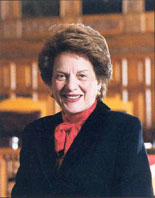In yesterday’s State of the State address, New York Gov. Eliot Spitzer asked for “a Constitutional amendment that incorporates Judge Kaye’s recommendations to consolidate and integrate our balkanized courts.”
Perhaps the happiest person to hear that (aside from a multitude of practitioners), was Chief Judge Judith Kaye. At her own State of the Judiciary speech for 2006, she described the frustrations involved with fixing New York’s arachaic court structure, and the decades long struggle to do so:
Since 1993 I have urged simplifying the archaic structure of New York’s courts, by far the most complex in America. Supreme Court and Family Court, Surrogate’s Court and the Court of Claims, superior criminal courts and local criminal courts — time and time again, whether the issue is matrimonials, or indigent defense, or simple efficiency, we have seen that jurisdictional barriers among New York’s trial courts fragment related cases, risk inconsistent judgments, discourage effective outcomes, encourage costly litigation, and confuse litigants and lawyers. We have had some notable operational successes, such as the Integrated Domestic Violence Courts and the Bronx Criminal Division. Despite these heroic efforts to work around the problems, however, there is no escaping the conclusion that our court structure is in need of repair.
I am discouraged, but not deterred, by the fact that my perennial call for this reform remains unheeded. Indeed, 2006 marks a full century since Dean Roscoe Pound’s historic speech to the American Bar Association, calling for states to unify their trial courts for the sake of efficiency and substantive justice. Over the last century, other states have heeded that call. In 1962, New York took the modest step of merging and unifying some of its courts, principally in New York City. But eleven trial courts is still a far cry from what Dean Pound envisioned when he urged unification, and a far cry from what Chief Judge Charles Breitel urged in 1974 when he joined that call.
Ensuring accountability, better protecting crime victims, reducing recidivism, reducing costs, making our courts more efficient, accessible and understandable — I have come to see more than ever before that without change in court structure, these benefits will continue to elude our State. Given the frustrations we’ve experienced in getting court reform off the ground, I’m convinced that it’s time for a new approach. I wondered: how did they do it back in 1962? That effort, as I learned, was actually inspired by the work of a commission set up in the mid-1950s, chaired by New York attorney Harrison Tweed, that studied the need for structural court reform and modernization of New York’s procedural codes.
Recognizing the success of the Tweed Commission, and the successes we have had in the last decade with our commissions, I will be forming a Special Commission on the Future of the New York State Courts to pick up where the Tweed Commission left off. Harnessing the expertise of the most respected lawyers, jurists and community leaders, this Commission will assess, candidly and without reservation, the effectiveness of our current structure, the need for reform, and whether our procedural codes — all of them now thirty or more years old –need streamlining as well.
The Commission will be asked to look at systems across the nation for ideas, and to propose a court structure that is free of barriers that force the unnecessary fragmentation of courts and cases, that is user-friendly, has the benefits of both specialization and simplicity and that is accessible to all New Yorkers; and to suggest procedures that complement such a streamlined system. That is a mighty task I know, but truly an important one for the future of our courts and justice system.
Will Gov. Spitzer, with the help of Judge Kaye, be able to marshall the forces for long needed change? Stay tuned…